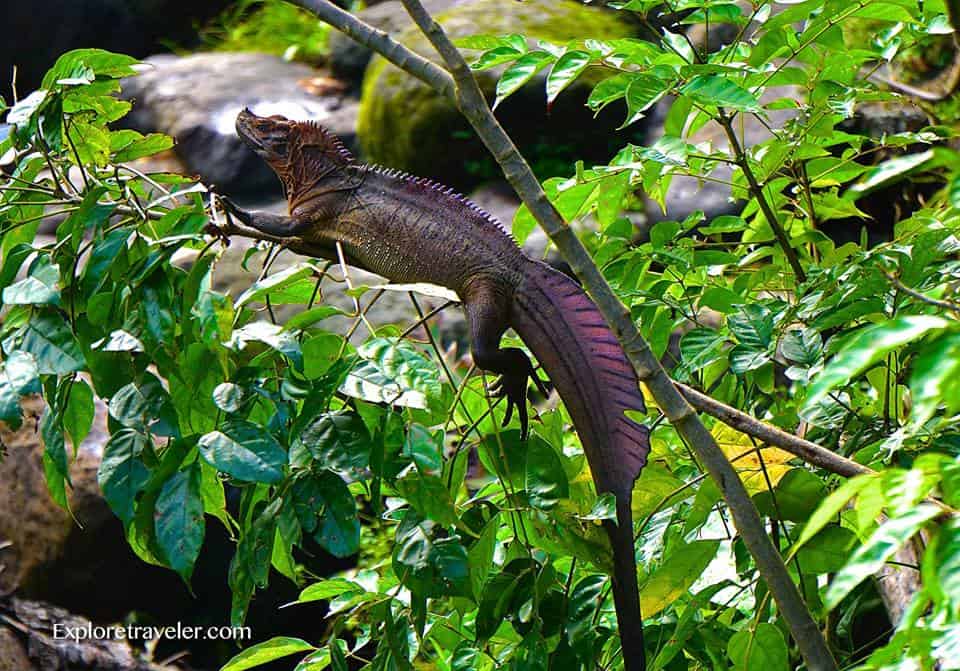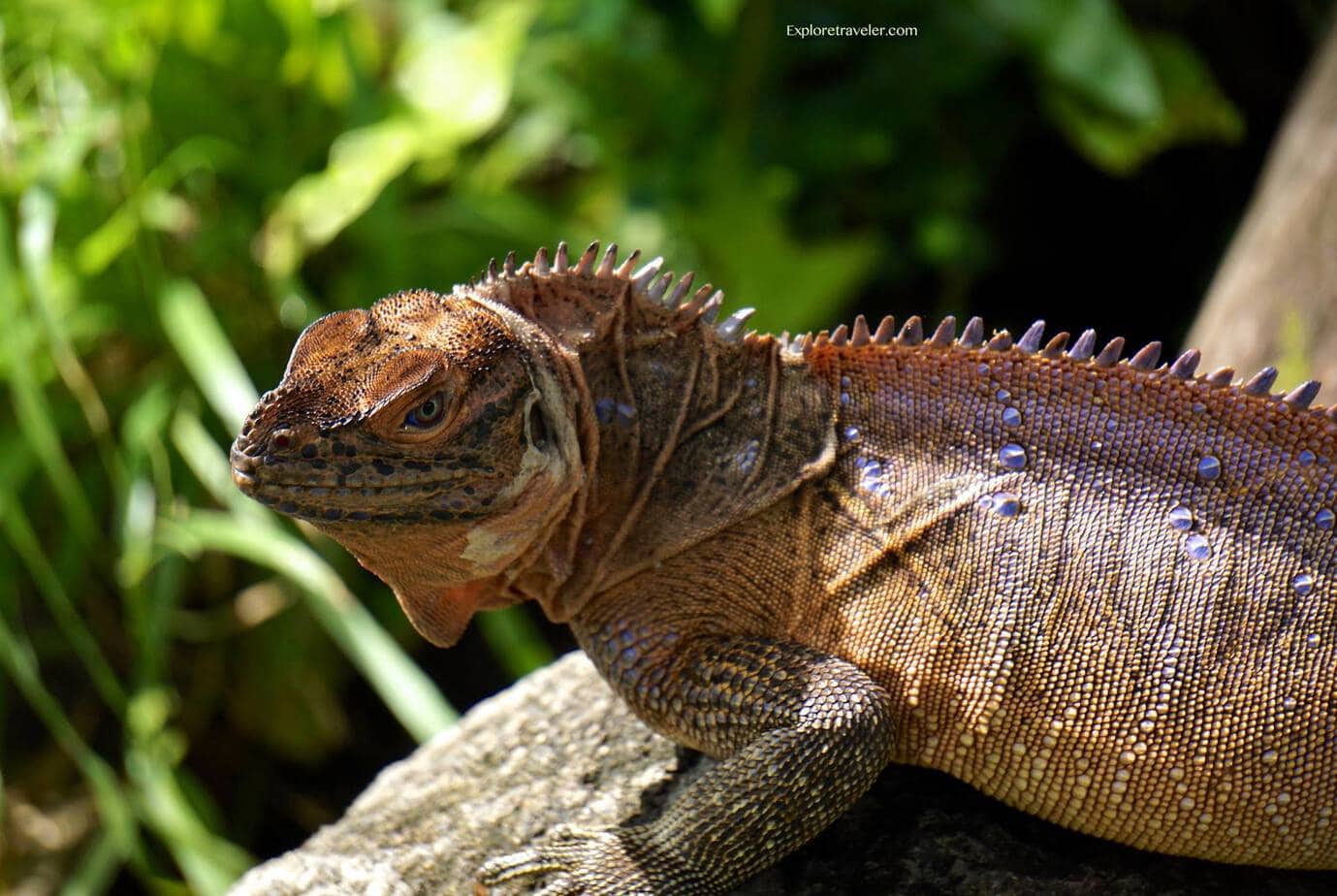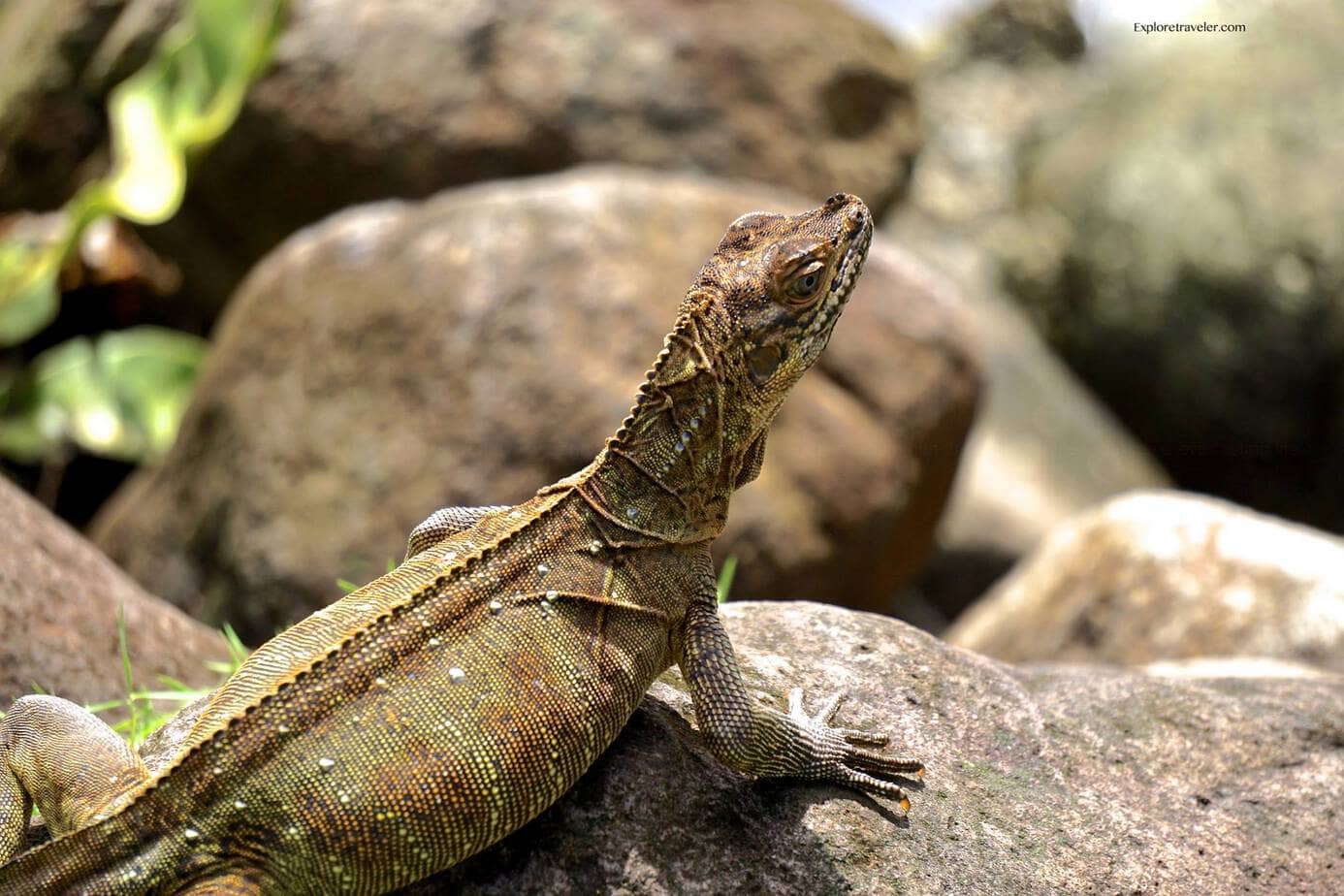Frequently Asked Questions
What to feed sailfin dragon?
Sailfin dragons should be fed a diet consisting of live insects such as crickets, mealworms, and waxworms. Additionally, leafy greens, fruits, and vegetables are important for their nutrition. It is essential to provide variety and ensure a balanced diet for their overall health and well-being.
Are Philippine sailfin lizards venomous?
The Philippine sailfin lizards are not venomous. They primarily use their intimidating appearance and behaviors to deter predators rather than relying on venom for defense. These lizards showcase their impressive sailfin displays to ward off potential threats without the use of venom.
How fast do sailfin dragons grow?
Sailfin dragons typically grow rapidly during their first year, reaching around 12 inches in length by the time they are 12 months old. However, growth rates can vary depending on factors like diet, environment, and overall health of the dragon.
Can you own a sailfin dragon?
Yes, you can own a sailfin dragon as a unique and fascinating pet. However, it's essential to research their care requirements thoroughly to ensure their well-being and longevity in captivity. Consider their specific habitat needs, diet, and social behaviors to provide a suitable environment for a sailfin dragon in your care.
How big does a sailfin dragon get?
Sailfin dragons can grow up to 3 feet in length. They are known for their impressive size and distinct appearance, making them a popular choice among reptile enthusiasts. Providing proper care and a spacious habitat is essential for their well-being as they reach their maximum size.
Are sailfin dragons friendly?
Sailfin dragons are generally docile and friendly when well cared for and handled properly. They can become accustomed to human interaction and may even enjoy being handled, although individual temperament can vary. It is essential to handle them gently and respectfully to maintain their friendly demeanor.
How big should a sailfin dragon enclosure be?
The sailfin dragon enclosure should be spacious, ideally providing ample room for climbing, basking, and exploring. A minimum enclosure size should be 4ft x 2ft x 2ft for a single adult, with larger dimensions recommended for multiple dragons or active individuals.
Are sailfin dragons aggressive?
Sailfin dragons are generally not considered aggressive. They are known to have a calm temperament and are often kept as pets due to their docile nature. However, like any animal, individual temperament may vary, and care should always be taken when handling them.
How big do sailfin dragons get?
Sailfin dragons can grow up to 3 feet in length, with their tail making up two-thirds of their body size. They are impressive reptiles known for their unique appearance and large size compared to other lizard species.
Are sailfin dragons poisonous?
Sailfin dragons are not poisonous.
How to tame a sailfin dragon?
To tame a sailfin dragon, approach with calm confidence, establish trust through positive interactions, offer food as a bonding gesture, and gradually introduce handling. Consistency, patience, and respect for the dragon's wild nature are key in forming a strong, respectful connection.
Is a sailfin dragon dangerous?
Sailfin dragons are not considered dangerous to humans. They are generally shy and non-aggressive, posing little threat. It is important to handle them with care due to their delicate nature rather than their aggressiveness.
Are sailfin dragons good pets?
Sailfin dragons can make good pets for experienced reptile owners. They require large enclosures, specific humidity levels, and a varied diet. Their stunning appearance and unique behavior can be rewarding for those willing to invest time and effort into their care.
Do sailfin dragons make good pets?
Sailfin dragons can make fascinating pets for experienced reptile owners willing to meet their specialized care needs. Their unique appearance and behavior can be a rewarding experience, but their requirements for habitat, diet, and handling make them unsuitable for beginners.
How long is a sailfin dragon?
The sailfin dragon can grow up to 3 feet in length, with most individuals reaching lengths between 2 to 2.5 feet. This size makes them an impressive and unique addition to any reptile collection, showcasing their beauty and stature as a captivating species to observe.
How much is a sailfin dragon?
The cost of a sailfin dragon can vary depending on factors such as age, size, and where you purchase it from. It is essential to research reputable breeders to ensure you are getting a healthy and ethically sourced sailfin dragon at a fair price.
Is the Philippine sailfin lizard venomous?
The Philippine sailfin lizard is not venomous. It is primarily known for its distinct appearance and calm demeanor, making it a popular choice among reptile enthusiasts. Despite its intimidating size and sharp claws, this species does not pose a threat due to its lack of venomous capabilities.
Is the Philippine sailfin lizard endangered?
The Philippine sailfin lizard is listed as a vulnerable species due to habitat loss and poaching. Efforts are being made to protect and conserve this unique reptile to prevent further population decline.
How often do sailfin dragons eat?
Sailfin dragons typically eat insects daily, with occasional feedings of small vertebrates. Juveniles may consume insects twice a day, while adults might feed every other day. A varied diet ensures nutritional balance and supports their active lifestyle.
Can I have a sailfin dragon as a pet?
Sailfin dragons require specialized care due to their unique habitat and dietary needs. Research their care requirements thoroughly before considering them as pets. They may not be suitable for all individuals due to their specific needs and the commitment required for their well-being.
How big sailfin dragon?
Sailfin dragons can grow up to 3 feet in length, making them quite sizable creatures in the reptile world. Their impressive size, coupled with their striking appearance and unique behaviors, make them a fascinating species for reptile enthusiasts and researchers alike.
What does a sailfin dragon look like?
A sailfin dragon is a lizard with vibrant colors and distinctive sail-like fins on its back. It has a long body, sharp claws, and a pointed snout. With a robust build and unique fin structures, it stands out as a visually striking reptile in its habitat.
What size tank does a lizard need?
The size of the tank for a lizard depends on the species and size of the lizard. Generally, a lizard needs a tank that allows for movement, hiding spots, basking areas, and ample space to explore. Ensure the tank accommodates their growth and behavioral needs.
How often to feed sailfin dragon?
Sailfin dragons should be fed daily with a variety of insects and leafy greens. It's important to monitor their appetite and adjust feeding frequency based on individual needs, ensuring they maintain a healthy diet and weight.
What does the sailfin dragon eat?
The sailfin dragon primarily eats insects, small vertebrates, and plants. Their diet consists of a variety of prey items such as crickets, mealworms, small fish, and fruits. They are opportunistic feeders and will consume whatever is readily available in their habitat.
Can you own a sailfin dragon in the US?
Yes, owning a sailfin dragon in the US is legal in most states, but it is important to check local laws and regulations before acquiring one as exotic pet ownership rules vary. It's crucial to ensure proper care, suitable habitat, and knowledge of their specific needs before taking on the responsibility.
Do sailfin dragons bite?
Sailfin dragons typically do not have a tendency to bite as they are generally docile creatures. However, in situations where they feel threatened or stressed, they may resort to biting as a form of defense. It is important to handle them gently and with care to avoid triggering any aggressive behavior.
What do baby sailfin dragons eat?
Baby sailfin dragons primarily eat small insects and invertebrates such as crickets, mealworms, and small worms. It is crucial to provide a varied diet to ensure they receive proper nutrition for healthy growth and development. Remember to dust their food with calcium and other essential supplements to support their overall health.
What do sailfin dragons eat?
Sailfin dragons primarily eat insects, including crickets and worms, as well as leafy greens and fruits. It is essential to provide a varied diet to ensure their nutritional needs are met. In captivity, offering a balanced mix of live insects and plant-based foods is essential for their health and well-being.
Are sailfin dragons venomous?
Sailfin dragons are not venomous. While they have impressive appearances with their bright colors and crests, these lizards do not possess venomous capabilities. They may display defensive behaviors when threatened, but their primary means of defense is through intimidation rather than venom.
Sailfin dragon where to buy?
Sailfin dragons are unique reptiles that require specialized care. It is important to find a reputable breeder or exotic pet store that specializes in exotic reptiles. Research online forums and reptile expos for potential sellers and always ensure the seller has proper permits and offers healthy specimens.
What is sailfin dragon?
The sailfin dragon is a type of lizard native to Southeast Asia. It is known for its striking appearance, with vibrant colors and large sail-like fins on its back. Sailfin dragons are arboreal creatures, spending much of their time in trees and bushes.
How do you care for a sailfin dragon?
To care for a sailfin dragon, ensure a proper habitat with UVB lighting, a basking spot, and a heated area. Provide a varied diet of insects, vegetables, and fruits, along with fresh water for hydration. Regularly clean the enclosure and monitor their health to ensure a thriving environment.
Are sailfin lizards endangered?
Sailfin lizards are not classified as endangered. Their populations are currently stable, and they are not considered at risk of extinction. Their habitats are still relatively intact, providing them with sufficient resources for survival.
Where do sailfin dragons live?
Sailfin dragons primarily inhabit the tropical forests and coastal regions of Indonesia, specifically found in areas with high humidity levels and dense vegetation. They are known to dwell near bodies of water, such as rivers, streams, and mangrove swamps, where they can bask in the sun and swim.
Sailfin dragon what do they eat?
Sailfin dragons are omnivores, consuming insects, fruits, and vegetation. A varied diet ensures proper nutrition and health for these captivating reptiles. Consider offering a mix of live prey, greens, and occasional fruits to meet their dietary needs and keep them thriving in captivity.
How much does a sailfin dragon weigh?
The sailfin dragon typically weighs between 2 to 3 pounds on average. However, this can vary depending on the specific age, size, and health of the individual dragon. It's essential to monitor their weight to ensure they are healthy and thriving in their environment.
Can you hold a sailfin dragon?
Sailfin dragons are wild animals and not typically recommended as pets due to their specialized care needs and potential for agitated behavior. It is advisable to avoid handling them to prevent stress or injury to both the animal and the handler.
Sailfin dragon how big?
Sailfin dragons can grow up to 3 feet long, with males typically larger than females. They are known for their vibrant colors and unique fin structures, making them a visually striking species of reptile.
Can you own sailfin dragons in Illinois?
Sailfin dragons are listed as restricted species in Illinois, requiring a permit for ownership. Possession without proper documentation may lead to legal consequences. It's essential to research and comply with state regulations before acquiring these reptiles.
How much do sailfin dragons cost?
The cost of sailfin dragons can vary depending on factors like age, size, and color morph. On average, prices can range from $50 to $500 in pet stores or through breeders, with additional costs for habitat setup and ongoing care. It's important to research reputable sources and consider all expenses before purchasing.
How old is my sailfin dragon?
Determining the age of a sailfin dragon can be challenging as they do not have easily identifiable age markers. However, you can estimate their age based on their size, behavior, and physical condition. Consulting a reptile veterinarian or experienced breeder may provide more insight into determining the approximate age of your sailfin dragon.
Sailfin dragon how big do they get?
Sailfin dragons can grow up to 3 feet in length, with males typically being larger than females. They are known for their impressive sail-like dorsal fin, which can be extended for display or folded down along their bodies. These creatures require spacious enclosures and specific care to thrive in captivity.
What can be kept with sailfin dragon?
Sailfin dragons can be kept with tank mates that are similar in size and temperament to avoid aggression. Suitable companions include other peaceful species that can thrive in the same water conditions as sailfin dragons, creating a harmonious aquatic environment for all inhabitants.
Sailfin dragon how to take care of?
Taking care of a Sailfin dragon involves providing a spacious enclosure with proper lighting, heating, and humidity levels. Offering a varied diet of insects and greens, along with regular veterinary check-ups and maintaining a clean environment are essential for their health and well-being. Regular handling and interaction can also help in building a bond with your Sailfin dragon.
Where are sailfin dragons from?
Sailfin dragons are native to the tropical rainforests of Indonesia and Papua New Guinea. Typically found near freshwater habitats, these arboreal lizards thrive in the warm, humid climates of Southeast Asia. With their striking appearance and unique characteristics, sailfin dragons are popular exotic pets among reptile enthusiasts.
What habitats do sailfin dragons prefer?
Sailfin dragons prefer habitats with dense vegetation, tall grass, and access to water sources like streams or ponds. They thrive in tropical climates with high humidity levels and enjoy basking in the sun on rocks or branches to regulate their body temperature.
Can sailfin dragons cohabit with other lizards?
Sailfin dragons should not cohabit with other lizards due to their territorial nature and potential aggression towards other species. It is best to house them alone to prevent any conflict or stress among the different reptiles.
What temperatures suit sailfin dragons best?
Sailfin dragons thrive in temperatures around 85 to 90 degrees Fahrenheit during the day and slightly cooler at night. It’s vital to provide a basking spot of 95 degrees Fahrenheit to help with digestion and overall well-being. UVB lighting and a proper gradient of heat throughout the enclosure are essential for their health and happiness.
Do sailfin dragons require UVB lighting?
Sailfin dragons do require UVB lighting as part of their habitat setup to help them properly absorb calcium and maintain overall health. It is crucial to provide the necessary UVB lighting for these reptiles to thrive in captivity.
Whats the lifespan of a sailfin dragon?
The lifespan of a sailfin dragon can range from 6 to 10 years, influenced by factors like diet, habitat, and overall care. Proper husbandry and a conducive environment can help maximize their lifespan.
How often should sailfin dragons be handled?
Avoid handling sailfin dragons excessively as it can cause stress and health issues. Limit interaction to necessary care tasks to minimize disruption to their natural behavior and environment. Regular observation from a distance is preferable over frequent handling for their well-being.
What are common health issues in sailfin dragons?
Common health issues in sailfin dragons may include metabolic bone disease, respiratory infections, dehydration, and parasites. Regular veterinary check-ups, proper diet, and habitat maintenance are crucial for ensuring their well-being. Paying attention to these factors can help prevent and address potential health issues in sailfin dragons.
Do sailfin dragons need a water feature?
Sailfin dragons do not require a water feature for swimming, as they are primarily terrestrial reptiles. However, providing a shallow dish for drinking and occasional soaking is recommended for their hydration and maintaining proper humidity levels in their habitat.
Can sailfin dragons eat fruit or vegetables?
Sailfin dragons primarily consume insects and small animals in the wild. While they may occasionally nibble on fruits or vegetables, these should not be a significant part of their diet as they require a primarily protein-based intake to thrive and stay healthy.
What predators threaten sailfin dragons in the wild?
Sailfin dragons in the wild face threats from predators such as birds of prey, snakes, larger lizards, and mammals. These predators target them due to their size and vulnerability, posing significant risks to the survival of sailfin dragons in their natural habitats.
How do sailfin dragons regulate their body temperature?
Sailfin dragons regulate their body temperature by basking in the sun to absorb heat, moving to shade to cool down, and adjusting their stance to control the amount of heat their body receives.
Can sailfin dragons be trained for handling?
Sailfin dragons can be trained for handling, but it requires patience, consistency, and positive reinforcement. Building trust with these exotic reptiles is key in successful handling training. Start with short sessions, gradually increasing time to acclimate them to human interaction.
Do sailfin dragons interact socially with each other?
Sailfin dragons do not exhibit strong social behaviors, as they are generally solitary reptiles. They typically prefer to live alone and only come together for mating purposes. In captivity, they may show some tolerance towards other sailfin dragons but do not engage in social interactions as seen in more social species.
What conservation efforts exist for sailfin dragons?
Conservation efforts for sailfin dragons include habitat protection, anti-poaching measures, research initiatives, and community education programs aimed at raising awareness about the importance of preserving these unique reptiles and their ecosystems. Collaboration with local communities and stakeholders is also crucial in ensuring the long-term survival of sailfin dragons.
How do sailfin dragons communicate?
Sailfin dragons communicate through a variety of visual cues, body language, and color changes. These behaviors include head bobbing, throat puffing, and displaying their impressive fin structures. Additionally, they may use sounds or hisses to express dominance or establish territory within their social hierarchy.
What is the breeding season for sailfin dragons?
Sailfin dragons breed from November to February in their natural habitat. During this time, males display vibrant colors to attract females. The breeding season marks a crucial period for these dragons to establish mating bonds and reproduce successfully.









